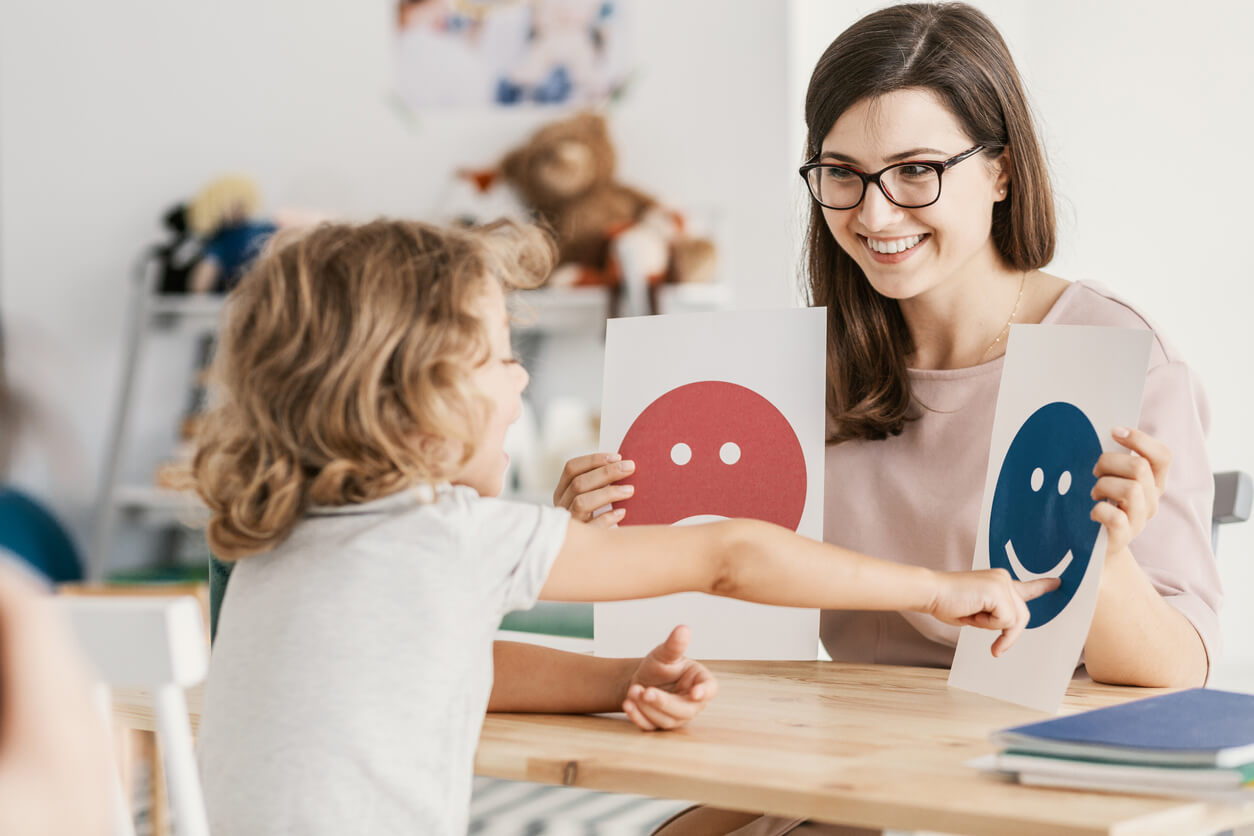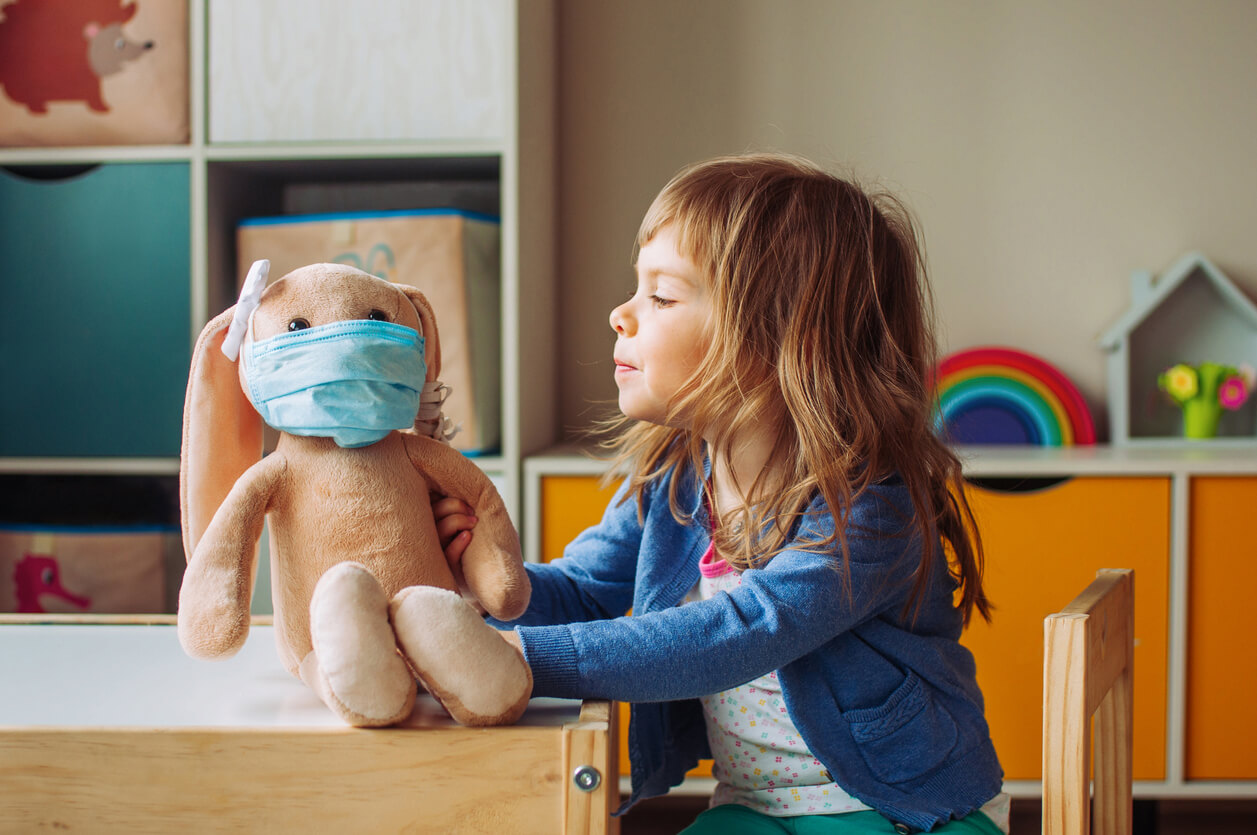6 Simple Techniques to Help Children Express Their Emotions


Written and verified by the psychologist Sharon Capeluto
Identifying and expressing emotions isn’t easy, especially for children. Throughout the day, people experience different emotions that give us information about how we feel about what’s happening. The point is that we’re not always aware of them, so, expressing them appropriately is a challenge. All this being said, in the following article, we’ll offer 6 techniques to help children express their emotions.
Techniques for children to learn to express their emotions
In this case, we’re talking specifically about emotional expression during childhood. Children are in the process of growing up, and it’s to be expected that they don’t yet know how to identify, name, or express what they feel. Here’s how to help children express emotions such as joy, sadness, fear, anger, or frustration.
1. Naming emotions
Emotions are as abstract as they are common. When adults name emotions in everyday life, little ones incorporate words like “happy”, “sad”, or “angry” in their vocabulary and better understand their meaning.
So, to help your children express how they feel, you can start by putting words to your own emotions. For example, if you’re waiting to be seen at the doctor’s office and you’re angry that the doctor is late, you can say, “I’m angry that the doctor is late. I’m angry that the doctor is taking so long to see you.” Or, if you’re walking through a beautiful park, you can say, “I am so happy to be here and to be able to spend time here. I’m so happy to be here having a good time.”

2. Identify the emotions of characters in stories and movies
Stories or movies are excellent opportunities for children to learn about emotions. From them, children can see their own emotions reflected in the characters.
Sometimes, recognizing what someone else feels can be easier than deciphering what your own feelings are. In this regard, it can be very useful to invite the children to talk about what happens in a movie or in the story in regard to moods. For example, you can guide the dialogue by asking questions such as What does this character feel? What made them feel this way? How would you feel in this situation?
3. Create a dictionary of emotions
Children need to know that emotions are a fundamental part of life and something that all human beings share. At the same time, it’s important to explain to them that, although some are pleasant and others unpleasant, every emotion is valid. Feeling them is natural and expressing them freely is important, as it helps us feel better.
So, how about creating a dictionary of emotions together? All you need is a nice notebook and a variety of pencils to write down in words or drawings what each emotion represents for them. The enormous amount of existing emotions could overwhelm children at first. Therefore, it’s good to start this project with the 6 basic emotions: anger, sadness, joy, disgust, fear, and surprise.
4. Play role-playing games
Gestures and facial expressions are the most visible part of emotions. They’re what’s visible to the naked eye and what often gives us a clue as to how the person we’re looking at is feeling.
Learning to express emotions can be very dynamic and fun. In this regard, mime or role-playing games can be very useful. For example, you can play that one chooses an emotion to recreate with the body, without uttering a word, and the other person has to guess what the emotion is. Something similar can be done with images from magazines, newspapers, or pictograms to identify the emotional states of those who appear in them.
5. Ask fun questions
Emotions are deeply complex mental processes. It’s not easy to describe them clearly in a few words. In order for children to get to know their own emotions better, we can ask them playful questions like these: In which part of the body do you feel anger? If joy were an object, what would it be? What if it were a color? If fear could talk to you, what would it tell you?
In addition, based on these questions, children will have to work on introspection while they enhance their creativity. It’s essential to reassure them, making it clear that there’s no right answer and emphasizing that this is a game where there are no winners or losers.

6. Carry out role-playing around everyday situations
Role-playing is a dynamic proposal that allows learning in a simple and witty way. Hypothetical situations that could happen at school, in public, or at home can be presented and the children can act as if they were acting out those moments. In addition, they should evaluate different alternatives to make a decision or try to resolve a conflict.
The importance of children learning to express their emotions
Expression is a basic aspect of emotional intelligence and is fundamental for people’s psychological health. It’s worth emphasizing that it’s possible to learn to express one’s feelings, even in adulthood.
However, children’s ability to express their emotions from an early age is profoundly significant. It’s a valuable tool for gaining support from others. It also helps develop empathy and assertiveness, while generating a sense of relief and release that results in greater emotional well-being.
Identifying and expressing emotions isn’t easy, especially for children. Throughout the day, people experience different emotions that give us information about how we feel about what’s happening. The point is that we’re not always aware of them, so, expressing them appropriately is a challenge. All this being said, in the following article, we’ll offer 6 techniques to help children express their emotions.
Techniques for children to learn to express their emotions
In this case, we’re talking specifically about emotional expression during childhood. Children are in the process of growing up, and it’s to be expected that they don’t yet know how to identify, name, or express what they feel. Here’s how to help children express emotions such as joy, sadness, fear, anger, or frustration.
1. Naming emotions
Emotions are as abstract as they are common. When adults name emotions in everyday life, little ones incorporate words like “happy”, “sad”, or “angry” in their vocabulary and better understand their meaning.
So, to help your children express how they feel, you can start by putting words to your own emotions. For example, if you’re waiting to be seen at the doctor’s office and you’re angry that the doctor is late, you can say, “I’m angry that the doctor is late. I’m angry that the doctor is taking so long to see you.” Or, if you’re walking through a beautiful park, you can say, “I am so happy to be here and to be able to spend time here. I’m so happy to be here having a good time.”

2. Identify the emotions of characters in stories and movies
Stories or movies are excellent opportunities for children to learn about emotions. From them, children can see their own emotions reflected in the characters.
Sometimes, recognizing what someone else feels can be easier than deciphering what your own feelings are. In this regard, it can be very useful to invite the children to talk about what happens in a movie or in the story in regard to moods. For example, you can guide the dialogue by asking questions such as What does this character feel? What made them feel this way? How would you feel in this situation?
3. Create a dictionary of emotions
Children need to know that emotions are a fundamental part of life and something that all human beings share. At the same time, it’s important to explain to them that, although some are pleasant and others unpleasant, every emotion is valid. Feeling them is natural and expressing them freely is important, as it helps us feel better.
So, how about creating a dictionary of emotions together? All you need is a nice notebook and a variety of pencils to write down in words or drawings what each emotion represents for them. The enormous amount of existing emotions could overwhelm children at first. Therefore, it’s good to start this project with the 6 basic emotions: anger, sadness, joy, disgust, fear, and surprise.
4. Play role-playing games
Gestures and facial expressions are the most visible part of emotions. They’re what’s visible to the naked eye and what often gives us a clue as to how the person we’re looking at is feeling.
Learning to express emotions can be very dynamic and fun. In this regard, mime or role-playing games can be very useful. For example, you can play that one chooses an emotion to recreate with the body, without uttering a word, and the other person has to guess what the emotion is. Something similar can be done with images from magazines, newspapers, or pictograms to identify the emotional states of those who appear in them.
5. Ask fun questions
Emotions are deeply complex mental processes. It’s not easy to describe them clearly in a few words. In order for children to get to know their own emotions better, we can ask them playful questions like these: In which part of the body do you feel anger? If joy were an object, what would it be? What if it were a color? If fear could talk to you, what would it tell you?
In addition, based on these questions, children will have to work on introspection while they enhance their creativity. It’s essential to reassure them, making it clear that there’s no right answer and emphasizing that this is a game where there are no winners or losers.

6. Carry out role-playing around everyday situations
Role-playing is a dynamic proposal that allows learning in a simple and witty way. Hypothetical situations that could happen at school, in public, or at home can be presented and the children can act as if they were acting out those moments. In addition, they should evaluate different alternatives to make a decision or try to resolve a conflict.
The importance of children learning to express their emotions
Expression is a basic aspect of emotional intelligence and is fundamental for people’s psychological health. It’s worth emphasizing that it’s possible to learn to express one’s feelings, even in adulthood.
However, children’s ability to express their emotions from an early age is profoundly significant. It’s a valuable tool for gaining support from others. It also helps develop empathy and assertiveness, while generating a sense of relief and release that results in greater emotional well-being.
All cited sources were thoroughly reviewed by our team to ensure their quality, reliability, currency, and validity. The bibliography of this article was considered reliable and of academic or scientific accuracy.
- Aresté-Grau, J. (2015). Las emociones en Educación Infantil: sentir, reconocer y expresar (Bachelor’s thesis).
- Muslera, M. (2016). Educación Emocional en niños de 3 a 6 años.
- Salguero, M. J. C. (2011). Importancia de la inteligencia emocional como contribución al desarrollo integral de los niños/as de educación infantil. Pedagogía magna, (11), 178-188.
This text is provided for informational purposes only and does not replace consultation with a professional. If in doubt, consult your specialist.








